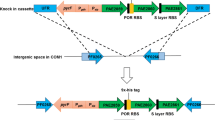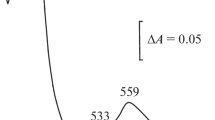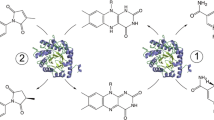Abstract
An NAD(P)H-dependent oxidoreductase has been purified approximately 40-fold from the soluble protein fraction of the dissimilatory iron-reducing, anaerobic, thermophilic bacterium Carboxydothermus ferrireducens. The enzyme, a flavoprotein, has broad-substrate specificity—reducing Fe3+, Cr6+, and AQDS with rates of 0.31, 0.33, and 3.3 U mg−1 protein and calculated NADH oxidation turnover numbers of 0.25, 0.25, and 2.5 s−1, respectively. Numerous quinones are reduced via a two-electron transfer from NAD(P)H to quinone, thus participating in managing oxidative stress by avoiding the formation of semiquinone radicals.



Similar content being viewed by others
Abbreviations
- NQO1:
-
NAD(P)H:quinone oxidoreductase 1
- CFOR:
-
Carboxydothermus ferrireducens NAD(P)H-dependent oxidoreductase
- AQDS:
-
9,10-Anthraquinone-2,6-disulfonate
- MES:
-
2-(N-morpholino)ethanesulfonic acid
- MOPS:
-
3-(N-morpholino)propanesulfonic acid
- TAPS:
-
N-Tris(hydroxymethyl)methyl-3-aminopropanesulfonic acid
- QH2 :
-
Reduced quinones
References
Beall HD, Mulcahy RT, Siegel D, Traver RD, Gibson NW, Ross D (1994) Metabolism of bioreductive antitumor compounds by purified rat and human DT-diaphorases. Cancer Res 54:3196–3201
Beyer RE, Segura-Aguilar J, Di Bernardo S, Cavazzoni M, Fato R, Fiorentini D, Galli MC, Setti M, Landi L, Lenaz G (1996) The role of DT-diaphorase in the maintenance of the reduced antioxidant form of coenzyme Q in membrane systems. Proc Natl Acad Sci USA 93:2528–2532
Bork P, Ouzounis C, Casari G, Schneider R, Sander C, Dolan M, Gilbert W, Gillevet PM (1995) Exploring the Mycoplasma capricolum genome: a minimal cell reveals its physiology. Mol Microbiol 16:955–967
Brewer PG, Spencer DW (1971) Colorimetric determination of manganese in anoxic waters. Limnol Oceanogr 16:107–112
Caccavo F, Coates JD, Rossello-Mora RA, Ludwig W, Schleifer KH, Lovley DR, McInerney MJ (1996) Geovibrio ferrireducens, a phylogenetically distinct dissimilatory Fe(III)-reducing bacterium. Arch Microbiol 165:370–376
Chakraborty S, Sakka M, Kimura T, Sakka K (2008) Cloning and expression of a Clostridium kluyveri gene responsible for diaphorase activity. Biosci Biotechnol Biochem 72:735–741
Cleland WW (1977) Determining the chemical mechanisms of enzyme-catalyzed reactions by kinetic studies. Adv Enzymol Relat Areas Mol Biol 45:273–387
Dailey HA, Lascelles J (1977) Reduction of iron and synthesis of protoheme by Spirillum itersonii and other organisms. J Bacteriol 129:815–820
Ernster L (1987) DT-diaphorase: a historical review. Chem Scr 27A:1–13
Fish WW (1988) Rapid colorimetric micromethod for the quantitation of complexed iron in biological samples. Methods Enzymol 158:357–364
Fontecave M, Coves J, Pierre JL (1994) Ferric reductases or flavin reductases? Biometals 7:3–8
Forsmark-Andrée P, Dallner G, Ernster L (1995) Endogenous ubiquinol prevents protein modification accompanying lipid peroxidation in beef heart submitochondrial particles. Free Radic Biol Med 19:749–757
Gonzalez CF, Ackerley DF, Lynch SV, Matin A (2005) ChrR, a soluble quinone reductase of Pseudomonas putida that defends against H2O2. J Biol Chem 280:22590–22595
Hausinger RP, Honer JF, Walsh C (1986) Separation of flavins and flavin analogs by high-performance liquid chromatography. Methods Enzymol 122:199–209
Johnson DL (1971) Simultaneous determination of arsenate and phosphate in natural waters. Environ Sci Technol 5:411–414
Laemmli UK (1970) Cleavage of structural proteins during the assembly of the head of bacteriophage T4. Nature 277:680–685
Louie TM, Xie XS, Xun L (2003) Coordinated production and utilization of FADH2 by NAD(P)H-flavin oxidoreductase and 4-hydroxyphenylacetate 3-monooxygenase. Biochemistry 42:7509–7517
Lovley DR, Coates JD, Blunt-Harris EL, Phillips EJP, Woodward JC (1996) Humic substances as electron acceptors for microbial respiration. Nature 382:445–448
Mihasan M, Chiribau CB, Friedrich T, Artenie V, Brandsch R (2007) An NAD(P)H-nicotine blue oxidoreductase is part of the nicotine regulon and may protect Arthrobacter nicotinovorans from oxidative stress during nicotine catabolism. Appl Environ Microbiol 73:2479–2485
Onyenwoke RU, Wiegel J (2007) Iron (III) reduction: a novel activity of the human NAD(P)H:oxidoreductase. Biochem Biophys Res Commun 353:389–393
Petrilli FL, de Flora S (1988) Metabolic reduction of chromium as a threshold mechanism limiting its in vivo activity. Sci Total Environ 71:357–364
Rao PV, Krishna CM, Zigler JS (1992) Identification and characterization of the enzymatic activity of zeta-crystallin from guinea pig lens. A novel NADPH: quinone oxidoreductase. J Biol Chem 267:96–102
Ross D, Siegel D (2004) NAD(P)H:quinone oxidoreductase 1 (NQO1, DT-diaphorase), functions and pharmacogenetics. Methods Enzymol 382:115–144
Sedláček V, Spanning RJ, Kučera I (2009) Characterization of the quinone reductase activity of the ferric reductase B protein from Paracoccus denitrificans. Arch Biochem Biophys 483:29–36
Segel IH (1975) Enzyme kinetics: behavior and analysis of rapid equilibrium and steady state enzyme systems. Wiley, Toronto
Siegel D, Gustafson DL, Dehn DL, Han JY, Boonchoong P, Berliner LJ, Ross D (2004) NAD(P)H:quinone oxidoreductase 1: role as a superoxide scavenger. Mol Pharmacol 65:1238–1247
Slobodkin A, Reysenbach AL, Strutz N, Dreier M, Wiegel J (1997) Thermoterrabacterium ferrireducens gen. nov., sp. nov., a thermophilic anaerobic dissimilatory Fe(III)-reducing bacterium from a continental hot spring. Int J Syst Bacteriol 47:541–547
Søballe B, Poole RK (1999) Microbial ubiquinones: multiple roles in respiration, gene regulation and oxidative stress management. Microbiology 145:1817–1830
Thorn JM, Barton JD, Dixon NE, Ollis DL, Edwards KJ (1995) Crystal structure of Escherichia coli QOR quinone oxidoreductase complexed with NADPH. J Mol Biol 249:785–799
Urone PF (1955) Stability of colorimetric reagent for chromium: s-diphenylcarbazides in various solvents. Anal Chem 27:1354–1355
Wang G, Maier RJ (2004) An NADPH quinone reductase of Helicobacter pylori plays an important role in oxidative stress resistance and host colonization. Infect Immun 72:1391–1396
Wu M, Ren Q, Durkin AS, Daugherty SC, Brinkac LM, Dodson RJ, Madupu R, Sullivan SA, Kolonay JF, Nelson WC, Tallon LJ, Jones KM, Ulrich LE, Gonzalez JM, Zhulin IB, Robb FT, Eisen JA (2005) Life in hot carbon monoxide: the complete genome sequence of Carboxydothermus hydrogenoformans Z-2901. PLoS Genet 1:563–574
Acknowledgments
We thank Drs. David Siegel and J. Samuel Zigler for the generous gifts of recombinant human NAD(P)H:quinone oxidoreductase and guinea pig zeta-crystallin protein, respectively, and Harry Dailey, Michael W.W. Adams, William B. Whitman, and Robert J. Maier for helpful discussions.
Author information
Authors and Affiliations
Corresponding author
Additional information
Communicated by A. Driessen.
Rights and permissions
About this article
Cite this article
Onyenwoke, R.U., Geyer, R. & Wiegel, J. Characterization of a soluble oxidoreductase from the thermophilic bacterium Carboxydothermus ferrireducens . Extremophiles 13, 687–693 (2009). https://doi.org/10.1007/s00792-009-0255-1
Received:
Accepted:
Published:
Issue Date:
DOI: https://doi.org/10.1007/s00792-009-0255-1




